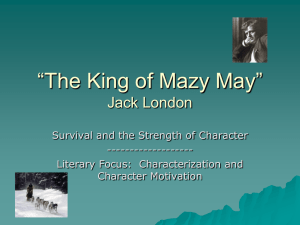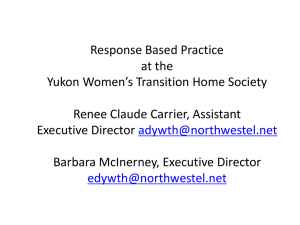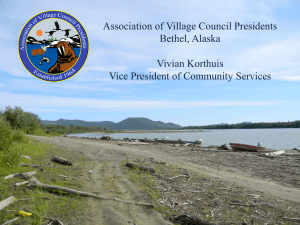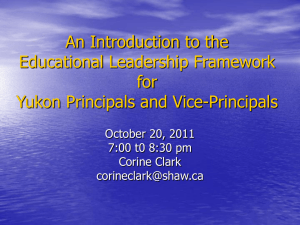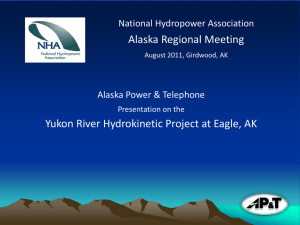landclaims
advertisement
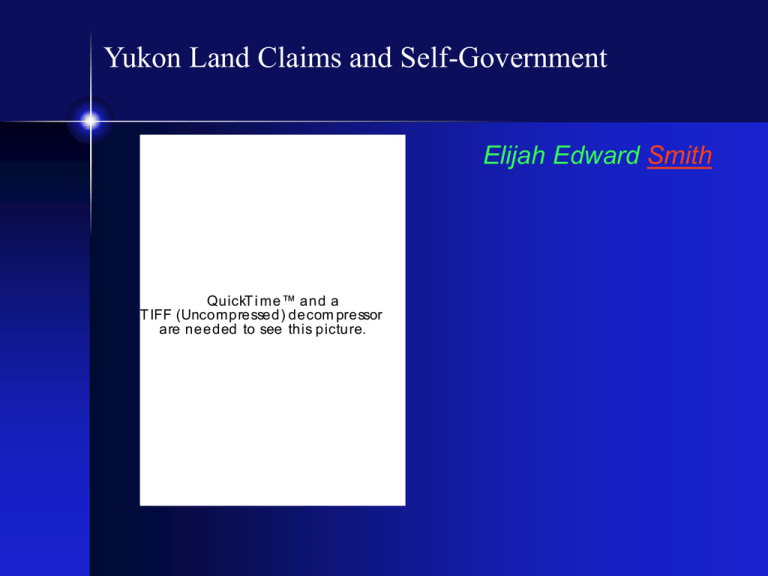
Yukon Land Claims and Self-Government Elijah Edward Smith QuickT i me™ and a T IFF (Uncompressed) decom pressor are needed to see this picture. Yukon Land Claims: A Brief History • 1763: Royal Proclamation of King George III recognizes aboriginal title and rights to land • 1902: Chief Jim Boss of the Ta'an Kwach'an requests compensation for lost lands and hunting grounds as a result of the Klondike Gold Rush. Boss' letter is ignored • 1972: with the publication of Together Today For our Children Tomorrow by Chief Elijah Smith current process started. • 1973: Yukon Indian Brotherhood and the Yukon Association of Non-Status Indians form Council for Yukon Indians (CYI) to negotiate a land claims agreement. Chief Jim Boss of the Ta'an Kwフロch'フロn First Nation Yukon Land Claims: A Brief History (Continued) • 1980: The two organizations and CYI merge under CYI name. • 1993: some justices of Supreme Court of Canada acknowledge concept of Aboriginal title (Nisga’a of Northern B.C.) • 1993: Umbrella Final Agreement (UFA) negotiations completed. • 1995: CYI was renamed to the Council of Yukon First Nations. Canada, 1990 Yukon Land Claims: A Brief History (Continued) • 2007 Q. How many Yukon First Nations have settled land claims? • A. Eleven. Agreements now are being implemented for those 11 self-governing Yukon First Nations. Listed below are the First Nations and the years their Final and Self-Government agreements were signed. • 1. Vuntut Gwitchin First Nation (1995) • 2. First Nation of the Nacho Nyak Dun (1995) • 3. Champagne and Aishihik First Nations (1995) • 4. Teslin Tlingit Council (1995) Yukon Land Claims: A Brief History (Continued) • 5. Selkirk First Nation (1997) • 6. Little Salmon/Carmacks First Nation (1997) • 7. Tr'ondëk Hwëch'in (formerly Dawson First Nation) (1998) • 8. Ta'an Kwäch'än Council (2002) • 9. Kluane First Nation (2003) • 10. Kwanlin Dün First Nation (2005) • 11. Carcross/Tagish First Nation (2006) • White River First Nation, Liard First Nation and Ross River Dena Council have not reached Final and Self-Government Agreements and remain Indian Bands under the federal Indian Act. Umbrella Final Agreement • UFA provided for a total amount of compensation and a land quantum amounting to about 8.5% of the Yukon's area (approx. 41,595 square km) to be returned to First Nations. • Most of the land is owned outright by First Nation governments, although a number of existing reserves were retained (eg. Old Village). • Each land claims agreement is also accompanied by a Self-Government agreement that gives First Nations the right to enact legislation in a number of areas. Umbrella Final Agreement Individual First Nations’ Land Claims/Self Government Terms you need to know: • Self-government: • Negotiated at the same time as the First Nation Final Agreement, • the F. N. Self-Government Agreement is a separate document that is not part of the treaty. • The Self-Government Agreement sets out powers of the First Nation government to govern itself, its citizens and its lands. • Some powers are similar to territorial governments, such as land and resource management, while other powers are similar to those of municipalities, such as local bylaws and zoning. • The Yukon Self-Government Agreements clarify that the Yukon Indian People are governed by their own constitution and are no longer governed under the federal Indian Act. The Yukon SelfGovernment agreements are unique in Canada. Terms you need to know: • Aboriginal Title: First Nations have the sovereign right to jurisdiction rule within traditional territories. Aboriginal groups can claim ownership if they prove they occupied it continuously and exclusively before CDN gov’t claimed sovereignty (1998). • Specific Claims: treaty signed between Aboriginal peoples and federal government, but terms have not been kept (think Mb., Sk., and Ab., Oka). • Comprehensive Claims: questions ownership of land in Canada never surrendered by treaty (think parts of B.C., Yukon). Terms you need to know: • Reserves: land reserved for use of Indian People under the Indian Act (e.g. Dawson Moosehide Creek). • Lands Set Aside: not ‘Reserves’, but land noted as set aside for Indian People at this time. • Category ‘A’ Settlement Lands: the band will have complete ownership of surface AND subsurface rights • Category ‘B’ Settlement Lands: complete ownership only of surface • Non-Settlement Lands: lands surrendered to the Federal Government Terms you need to know: • Public Access (to Settlement Lands): not allowed except: • 1. Emergency, • 2. occasional recreational purposes involving less than 15 people, • 3. the access is of a casual or unimportant nature • Outfitters can cross settlement lands to access their concessions as long as they do not hunt and camps are temporary • Trans-boundary: land claimed by more than one F.N. The nations involved must settle dispute before land claim with Fed. Gov’t is settled Terms you need to know: • Fish and Wildlife: Management Structure: A. First Nations Band -manage F&W on settlement lands -decide Adjusted Basic Needs Level B. Renewable Resources Councils (one for each F.N. traditional area, 3 persons by F.N. and 3 persons by minister) -suggest policies C. Fish and Wildlife Management Board (one for the whole Yukon, 6 by F.N.’s and 6 by minister) -determines Total Allowable Harvest by species QuickTime™ and a TIFF (Uncompressed) decompressor are needed to see this picture. Think about this… Total Allowable Harvest: maximum number of animals allowed to be taken be Indian and Non-Indian people in one year. Basic Needs Level: total number of animals that each F.N. will need each year. For example: F. N. BNL = 500 moose TAH = 1000 moose = 500 moose for Non-Indians For example: F.N. BNL = 500 moose TAH = 400 moose = 400 moose ALL for F.N.’s Terms you need to know: • Financial Compensation: the 14 Yukon F. N.’s receive $242,673,000 (in 1989 dollars) as financial compensation. • paid out over 15 years starting when an individual First Nation finalizes its agreement, minus deductions for loans (25% of their total compensation) used by the F. N.’s to negotiate the treaty. Words to think about…. "One does not sell the land people walk on." ... Crazy Horse, Sept. 23, 1875 "No tribe has the right to sell....Sell a country! Why not sell the air, the great sea, as well as the earth? Didn't the Great Spirit make them all for the use of his children?" -Tecumseh (Shawnee visionary)


